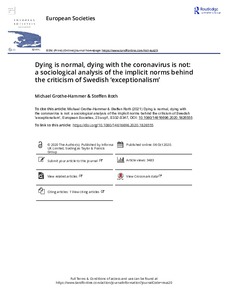Dying is normal, dying with the coronavirus is not - a sociological analysis of the implicit norms behind the criticism of Swedish 'exceptionalism'
Grothe-Hammer Michael; Roth Steffen
https://urn.fi/URN:NBN:fi-fe2021042826720
Tiivistelmä
From the outset of the coronavirus crisis, Sweden has been heavyily criticized for its exceptional pandemic mitigation policy. Sweden is often accused pursuing an abnormal and ‘disastrous strategy’ that puts its citizens’ lives at risk. In this article, we analyze the most widespread criticisms of Swedish ‘exceptionalism’, in order to identify and describe the prevailing implicit norms on which the criticisms are based. While the explicitly proclaimed norms assert that the anti-pandemic measures are aimed at keeping the number of infections below the maximum capacities of the national health systems, the implicit norms turn out to be significantly different, i.e. primarily about the number of coronavirus-related deaths. Moreover, we point out that this norm is not about protecting lives in general, but only about protecting people from dying with a coronavirus infection. We argue that this implicit norm is asymmetric and therefore not tenable, because it implies that a death from the coronavirus is considered more important than a death from another infection. Against this backdrop, we conclude by discussing possible future developments of this norm and call for an international public debate about how much protection against infectious diseases society should provide in general – not only against one particular disease.
Kokoelmat
- Rinnakkaistallenteet [27094]
